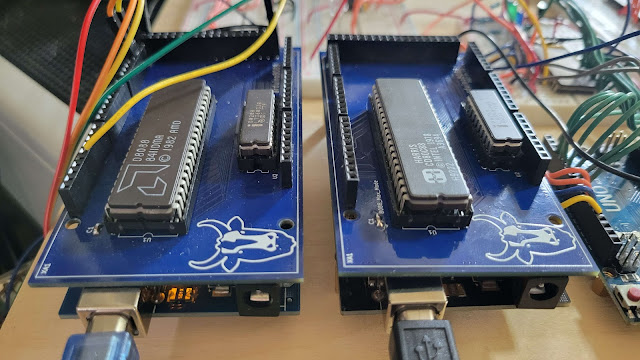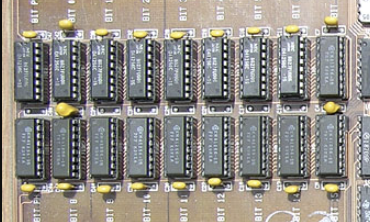A Test Suite for the Intel 8088
In a previous article, I revealed one of the secrets to MartyPC's accuracy, hardware validation. To summarize, it is a method of using a microcontroller to run an instruction on a real 8088 CPU at the same time as the emulator executes the same an instruction, and then comparing the resulting cycle states (and optionally registers) for consistency.
Once again, credit goes to phix and his VirtualXT emulator for pioneering this basic idea.
The downside to this method is that it is quite slow, and requires going out and buying a Raspberry Pi or an Arduino, ordering some vintage chips off eBay, then either breadboarding up a CPU or ordering a custom PCB and soldering it together, not to mention the the effort of integrating client communication and test logic into your emulator. All this presents a barrier to entry that makes this method probably only suitable for an especially dedicated few.
Compounding things, it's not really practical to validate instructions that frequently. Every time you tweak something as fundamental as BIU logic, you need to validate your emulator all over again, and validating the entire ISA can take many hours.
In that same blog post I bemoaned the lack of a JSON test suite for the 8088 CPU. I'm happy to announce that as of now, the 8088 no longer lacks a test suite! With the help of my friend Folkert van Heusden, we have taken three Arduino8088 hardware boards and spent the past week or so generating the first complete JSON CPU test suite for the 8088.
 |
| My two Arduino8088 boards busy generating tests |
JSON CPU Tests
A bit of a background if you're not familiar with the concept of a JSON CPU test suite. The idea was originally popularized by Tom Harte, as far as I can tell. JSON is a highly portable data format with readily available parsers in almost every language, saving emulator developers the trouble of writing a custom parser for a binary format. JSON isn't the most efficient storage format, so these JSON files can be a bit weighty - larger test sets are gzipped to keep the repository sizes reasonable.
Each JSON file typically corresponds to a single opcode, and contains an array of randomized tests that include the initial and final states of memory and CPU registers, and an array of data for each cycle spent executing that opcode.
Tom's CPU tests have been very well received in the emulation development community, giving a valuable and convenient way to quickly locate and squash emulation bugs that might otherwise take weeks of debugging to catch. Ever since developing the Arduino8088, I realized that using it to generate a set of tests was theoretically possible if I put in the work.
A number of CPU test authors have collaborated to combine their efforts, hosting test for various CPU architectures in the SingleStepTests organization on GitHub.
The 8088 Test Suite
The 8088 Test Suite is fairly comprehensive, exercising 10,000 tests not just on the opcode level but on the opcode extension level as well, with only a handful of opcodes omitted due to practicality (WAIT, HALT) or unpredictability (mostly certain undefined opcode forms).
The test suite contains 324 opcode forms, over 3 million instruction tests in total, including nearly 90 million cycle states. Compressed, the collection weighs in at 677 MB. The uncompressed, pretty-printed JSON totals 9.68GB.
That's a lot of test data!
Example Test
Here's an example test entry:
{
"name": "add byte ds:[bx+si+C2h], al",
"bytes": [0, 64, 194],
"initial": {
"regs": {
"ax": 52773,
"bx": 22214,
"cx": 16054,
"dx": 57938,
"cs": 60492,
"ss": 17184,
"ds": 15619,
"es": 60510,
"sp": 56738,
"bp": 13363,
"si": 58400,
"di": 31158,
"ip": 16937,
"flags": 62535
},
"ram": [
[264920, 71],
[984809, 0],
[984810, 64],
[984811, 194],
[984812, 144],
[984813, 144],
[984814, 144],
[984815, 144]
],
"queue": []
},
"final": {
"regs": {
"ax": 52773,
"bx": 22214,
"cx": 16054,
"dx": 57938,
"cs": 60492,
"ss": 17184,
"ds": 15619,
"es": 60510,
"sp": 56738,
"bp": 13363,
"si": 58400,
"di": 31158,
"ip": 16940,
"flags": 62470
},
"ram": [
[264920, 108],
[984809, 0],
[984810, 64],
[984811, 194],
[984812, 144],
[984813, 144],
[984814, 144],
[984815, 144]
],
"queue": [144, 144, 144]
},
"cycles": [
["-", 984810, "CS", "R--", "---", 0, "CODE", "T2", "F", 0],
["-", 984810, "CS", "R--", "---", 64, "PASV", "T3", "-", 0],
["-", 984810, "CS", "---", "---", 0, "PASV", "T4", "-", 0],
["A", 984811, "--", "---", "---", 0, "CODE", "T1", "-", 0],
["-", 984811, "CS", "R--", "---", 0, "CODE", "T2", "S", 64],
["-", 984811, "CS", "R--", "---", 194, "PASV", "T3", "-", 0],
["-", 984811, "CS", "---", "---", 0, "PASV", "T4", "-", 0],
["A", 984812, "--", "---", "---", 0, "CODE", "T1", "-", 0],
["-", 984812, "CS", "R--", "---", 0, "CODE", "T2", "-", 0],
["-", 984812, "CS", "R--", "---", 144, "PASV", "T3", "-", 0],
["-", 984812, "CS", "---", "---", 0, "PASV", "T4", "S", 194],
["A", 984813, "--", "---", "---", 0, "CODE", "T1", "-", 0],
["-", 984813, "CS", "R--", "---", 0, "CODE", "T2", "-", 0],
["-", 984813, "CS", "R--", "---", 144, "PASV", "T3", "-", 0],
["-", 984813, "CS", "---", "---", 0, "PASV", "T4", "-", 0],
["-", 984813, "--", "---", "---", 0, "PASV", "Ti", "-", 0],
["-", 984813, "--", "---", "---", 0, "PASV", "Ti", "-", 0],
["A", 264920, "--", "---", "---", 0, "MEMR", "T1", "-", 0],
["-", 264920, "DS", "R--", "---", 0, "MEMR", "T2", "-", 0],
["-", 264920, "DS", "R--", "---", 71, "PASV", "T3", "-", 0],
["-", 264920, "DS", "---", "---", 0, "PASV", "T4", "-", 0],
["A", 984814, "--", "---", "---", 0, "CODE", "T1", "-", 0],
["-", 984814, "CS", "R--", "---", 0, "CODE", "T2", "-", 0],
["-", 984814, "CS", "R--", "---", 144, "PASV", "T3", "-", 0],
["-", 984814, "CS", "---", "---", 0, "PASV", "T4", "-", 0],
["A", 984815, "--", "---", "---", 0, "CODE", "T1", "-", 0],
["-", 984815, "CS", "R--", "---", 0, "CODE", "T2", "-", 0],
["-", 984815, "CS", "R--", "---", 144, "PASV", "T3", "-", 0],
["-", 984815, "CS", "---", "---", 0, "PASV", "T4", "-", 0],
["A", 264920, "--", "---", "---", 0, "MEMW", "T1", "-", 0],
["-", 264920, "DS", "-A-", "---", 0, "MEMW", "T2", "-", 0],
["-", 264920, "DS", "-AW", "---", 108, "PASV", "T3", "-", 0]
]
}
A Rust Implementation
file.read_to_string(&mut file_string).expect("Error reading in JSON file to string!"); result = match serde_json::from_str(&file_string) { Ok(json_obj) => Some(json_obj), Err(e) if e.is_eof() => { println!("JSON file {:?} is empty. Creating new vector.", test_path); Some(LinkedList::new()) } Err(e) => { eprintln!("Failed to read json from file: {:?}: {:?}", test_path, e); None } }
// Set up CPU registers to initial state. println!("Setting up initial register state..."); println!("{}",test.initial_state.regs); // Set reset vector to our test instruction ip. let cs = test.initial_state.regs.cs; let ip = test.initial_state.regs.ip; cpu.set_reset_vector(CpuAddress::Segmented(cs, ip)); cpu.reset(); cpu.set_register16(Register16::AX, test.initial_state.regs.ax); cpu.set_register16(Register16::CX, test.initial_state.regs.cx); cpu.set_register16(Register16::DX, test.initial_state.regs.dx); cpu.set_register16(Register16::BX, test.initial_state.regs.bx); cpu.set_register16(Register16::SP, test.initial_state.regs.sp); cpu.set_register16(Register16::BP, test.initial_state.regs.bp); cpu.set_register16(Register16::SI, test.initial_state.regs.si); cpu.set_register16(Register16::DI, test.initial_state.regs.di); cpu.set_register16(Register16::ES, test.initial_state.regs.es); cpu.set_register16(Register16::CS, test.initial_state.regs.cs); cpu.set_register16(Register16::SS, test.initial_state.regs.ss); cpu.set_register16(Register16::DS, test.initial_state.regs.ds); cpu.set_register16(Register16::IP, test.initial_state.regs.ip); cpu.set_flags(test.initial_state.regs.flags); // Set up memory to initial state. println!("Setting up initial memory state. {} memory states provided.", test.initial_state.ram.len()); for mem_entry in &test.initial_state.ram { // Validate that mem_entry[1] fits in u8. let byte: u8 = mem_entry[1].try_into().expect(&format!("Invalid memory byte value: {:?}", mem_entry[1])); cpu.bus_mut().write_u8(mem_entry[0] as usize, byte, 0).expect("Failed to write memory"); }
// We loop here to handle REP string instructions, which are broken up into 1 effective instruction // execution per iteration. The 8088 makes no such distinction. loop { match cpu.step(false) { Ok((step_result, cycles)) => { println!("Instruction reported result {:?}, {} cycles", step_result, cycles); if rep & cpu.in_rep() { continue } break; }, Err(err) => { eprintln!("CPU Error: {}\n", err); cpu.trace_flush(); panic!("CPU Error: {}\n", err); } } } // CPU is done with execution. Check final state. println!("CPU completed execution."); // Get cycle states and registers from CPU. let mut cpu_cycles = cpu.get_cycle_states().clone();
let cpu_regs = cpu.get_vregisters();
// Validate final memory state. for mem_entry in &test.final_state.ram { // Validate that mem_entry[0] < 1MB if mem_entry[0] > 0xFFFFF { panic!("Test {}: Invalid memory address value: {:?}", n, mem_entry[0]); } let addr: usize = mem_entry[0] as usize; // Validate that mem_entry[1] fits in u8. let byte: u8 = mem_entry[1].try_into().expect(&format!("Test {}: Invalid memory byte value: {:?}", n, mem_entry[1])); let mem_byte = cpu.bus().peek_u8(addr).expect("Failed to read memory!"); if byte != mem_byte { eprintln!("Test {}: Memory validation error. Address: {:05X} Test value: {:02X} Actual value: {:02X}", n, addr, byte, mem_byte); results.pass = false; } }


Comments
Post a Comment